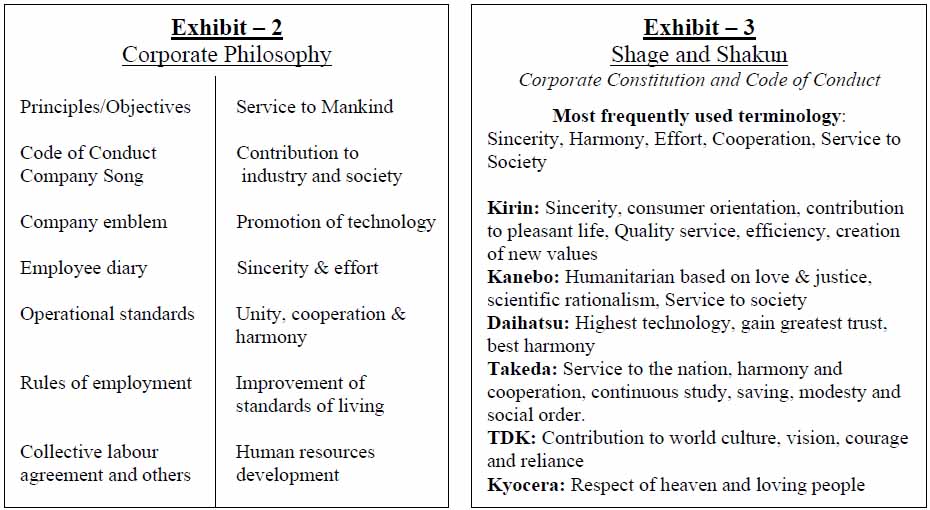Japanese Management Style
OMIKOSHI MANAGEMENT
Japanese management is called omikoshi management. Omikoshi refers to the young men who carry the portable shrine in festival parades. It is impossible to identify the leader or those who are, or are not, carrying their fair load. Thus, all are anonymous contributors to the group. Japanese management has the responsibility to create a harmonious environment in which each member of the group effectively contributes to group goals. Japanese feel that the nail that sticks up must be hammered down.
GAMBARE
Japanese have a term, gambare, which means to persevere, endure, or not give up. Factory walls are covered with banners touting various gambare slogans and managers often use gambare during a pep talk. However, gambare is an emotional tool that clouds rational thought and minimizes risk management. Gambare makes the Japanese push too hard and fast without evaluating the consequences of their actions.
NON-PROGRAMMED DECISION MAKING
Japanese managers use non-programmed decision making which entails gathering and analyzing data and information for the purpose of identifying and solving a problem. Two methods of non-programmed decision-making are: rational decision-making and sacrificing decision-making. Rational decision-making involves:
1. Investigating and defining the problem.
2. Establishing the criteria as a basis to make a decision.
3. Identifying alternative choices.
4. Evaluating each choice based on the established criteria.
5. Selecting the optimum choice (highest quantitative value).
6. Implementation.
In contrast, sacrificing decision-making is based on managers having incomplete information, and therefore, managers have to sacrifice by making a decision based on the first choice that meets the minimum criteria. Managers using this decision making process do not identify alternative choices.
LIFETIME EMPLOYMENT
Lifetime employment is a distinctive characteristic of Japan’s postwar labor system, although it never applied to many workers in the labor force and is now declining. This is how the system works: Large companies hire regular employees right out of school and keep them until retirement. New employees are chosen for their general potential, not because of any special skills or training. Such employees are considered the company’s human capital, to be trained, cultivated, and assigned to posts in the company’s best interest. Although there is no written contract guaranteeing lifetime employment, both employer and employee understand their mutual obligations under this system. The employee is to serve the company loyally and not try to leave for a better position. The employer will not dismiss or lay off the employee even in severe economic conditions. In addition, strong labor laws protect workers from being dismissed. This system also means that large firms train and promote their own employees to fill higher managerial positions, rather than hiring specialists or senior managers from outside the company. This system worked well during Japan’s long period of postwar economic growth with a young, energetic work force. In the 1990, during a prolonged economic recession and with an aging workforce, the lifetime employment system has begun to break down.
NEMAWASHI
Nemawashi is an informal participative decision making process of quietly laying the foundation for some proposed change or project, by talking to the people concerned, gathering support and feedback, and so forth. It is considered an important element in any major change, before any formal steps are taken, and successful nemawashi enables changes to be carried out with the consent of all sides.
RINGI SYSTEM
A management technique in Japanese companies in which low-level managers discuss a new idea among themselves and come to a consensus before presenting it to higher managers. The higher ranking managers then discuss the new idea themselves and arrive at their own consensus. This process continues until the idea comes to the highest management level and the idea is (or is not) implemented. Proponents claim that this system allows whole sections of a company to take credit for a new idea, while critics contend that it is time-consuming and hampers innovation.
INTRODUCTION TO CHARACTERISTICS OF JAPANESE MANAGEMENT STYLE FOR BETTER UNDERSTANDING OF CULTURAL DIFFERENCES IN COMPARING MBTI DATA OF JAPAN WITH THAT OF OTHER COUNTRIES
CHARACTERISTICS OF THE JAPANESE MANAGEMENT STYLE
1. People, rather than things or money, are at the center of Japanese management.
2. The aim of restoration of mass production to organize people and skills effectively under democratic policy.
3. Lifetime employment, that is large companies hire regular employees’ right out of school and keep them until retirement.
4. Seniority system for salaries and promotions rather than on the basis of performance.
5. The relationship among the employees and employer is like family members and taking responsibility for each other.
6. Employee’s contract is not created based upon job description.
7. Analyzing an employee’s ability and aptitude, and then place the “right” people in the “right” position within the organization.
8. Clerical positions and also, specialists’ jobs are very similar in western corporations.
9. Popular training program which is “Guess Who Game.” Here the participants are encouraged to guess their own and other employees’ type from their comments and a trainer then gives them an opportunity to consider applications to communication in the workplace.
HIRING: EMPHASIZING PEOPLE RATHER THAN JOB RESPONSIBILITIES [CONTRAST BETWEEN THE WEST AND JAPAN]
The relationship between organizations and people is basically different in Japan when compared with western countries. In the West, the minimum unit within the organization is considered the “job” and individuals relate to the organization by performing their “jobs.” For that reason, job analysis is essential and job descriptions are adhered to by employees who actually perform the jobs. In the hiring procedure, serious consideration is given to matching an applicant’s aptitude with an employer’s job requirements. On the other hand, in Japanese organizations, the minimum unit is considered a “person.” The relationship between people and organizations is very direct and organizations believe that these “people” create their jobs instead of the organizations offering them “job descriptions.” Thus, the sphere of job requirements may change according to the people who perform the jobs. This may be a unique characteristic. Thus, Japanese management does not emphasize the importance of preparing job analysis, descriptions, and requirements.
REASON OF EMPHASIZING ADOPTION OF CORPORATE CULTURE RATHER THAN ADAPTATION TO JOB
In many western corporations, the decision to hire an applicant is based upon his/her suitability for the job requirements. However, in the Japanese organization, an applicant is evaluated based upon whether or not he/she is suitable for the corporate culture on the assumption that the individual has high potential for future performance. Furthermore, the organization emphasizes the importance of evaluating an applicant based on whether he or she is totally acceptable as a family member of the corporation.
TREATMENT SYSTEMS OF SALARY OF JAPAN AND WESTERN COUNTRIES
In western countries, salaries reflect what a job itself requires, whereas in Japan, salaries are determined based upon employees’ competence, depending upon where they are classified within the corporation. In other words, western corporations set job descriptions according to job analysis, and employees’ salaries are determined by which position they are hired for. In contrast, Japanese corporations emphasize the importance of such factors as educational background, length of employment, and competency when determining salary. Thus, in Western countries, if salaries are decided based upon a job itself, there is a possibility that each new graduate from the same university will have a different salary at the entry position. However, in Japan, all new graduates will receive the same salary at the entry level because of Japan’s “competency system” for determining salaries. After hiring, similar to western corporations, there is a regular annual increase or promotion according to performance reviews. However, there is a difference in that, as a general rule, there is no demotion in the Japanese corporation. This system, not dependent on job description, is one very Japanese style of management.
TRAINING PROGRAMS
Japanese corporations hire college graduates who have little or no work experience. Although it has become popular to hire mid-career people for jobs that require experience and specific skills in the Japanese corporation, the most popular method is still to hire new graduates collectively when they graduate and educate them “from the ground up.” They are followed following training and development programs:
1. On-the-job training programs created for employees in the corporation are designed to train for the particular needs of a workplace, such as office management, business knowledge, and the acquisition of related skills.
2. Off-the-job training programs include a variety of courses, such as training for classified employees, outside seminars, correspondence courses, short-term exchange programs with other corporations, and going abroad to attend college.
JAPANESE STYLE MANAGEMENT [AN OVERVIEW]
MANAGEMENT PHILOSOPHY, OWNERSHIP STRUCTURE AND CORPORATE STRUCTURE
Management Philosophy
The concepts of “Wa” (harmony) and “service to the nation and society” can be found expressed in company creeds and mottoes. Every company has its own corporate or management philosophy expressed in various ways. The most common forms of expression are “Shage” (corporate constitution) and “Shakun” (code of behavior).
Sincerity and harmony are the most favored in Japanes Management. Refer Exhibit -2 and 3 for some examples of “Shage” and “Shakun”. Recently, it has become fashionable among companies to establish and propagate a corporate identity (CI) to improve the corporate image.
Ownership Structure:
The vast majority of typical Japanese companies are not family-owned. Some of these exceptions are Toyota Motor Corporation, Oobayashi Corporation, Taisho Pharmaceuticals Co, Santory Ltd, and a few others some others .The owners are mainly financial institutions and companies that are affiliated to the same business group. Refer to Exhibit-4 for example.
The relationship among the group member institutions are mutual assistance and stockholding, interlocking directors, human resource development, joint R & D, independent members, no holding company, regular meetings.
Corporate Structure:
The top-management in Japanese companies has an extremely closed structure. Although two or three directors may be invited to join the company from outside, in most cases, directors are appointed from within the company’s former management level-staff. Moreover, employees are not considered to be consumable physical resources, but as important corporate members in the corporate structure. Refer Exhibit-5 for the typical roles at different level in a Japanese company.
HUMAN RESOURCES MANAGEMENT PRACTICES
The personnel and human resources management practices of Japanese companies are mainly oriented towards people and their development. There are some specific characteristics, which are not found in the traditional western management system. Some of these distinct characteristics are:
1. Lifetime Employment: The lifetime employment system involves hiring people who have just graduated a high rate of stability among employees and guaranteeing work until the mandatory retirement age. The system is oriented towards human relations, human development and training guaranteed employment, equality, participation and welfare.
2. Seniority based promotion and wage system: The promotion from lower level to immediate higher level is mostly based on seniority. However, the pace of promotion is very slow though. It does not mean to say that promotion does not take account of performance evaluation and qualification of the employee. Higher weight age is given to senior person, or on the number of years he or she has worked with the company. Wage structure is also based on seniority.
3. Groupism: The special cultural quality of Japanese society has a great deal of impact on the Japanese management practices. The typical Japanese ways of thinking –”Uchi” (insider) and “Soto” (outsider) is actually practiced in Japanese management system. The special character of “WE” is very strong in Japanese companies.
OPERATIONS/PRODUCTION MANAEMENT PRACTICES
The Japanese production management system attempts to pursue efficiency in connection with work while at the same time, shows due considerations for human factors in the company. Some of the major distinctions can be found in the just in Time production system, subcontracting and quality control.
1. Just-In-Time (The Production) System: Producing and dispatching the products just in time is the main objective of employing JIT. This contains many other areas of improvement like low cost of production, low inventory cost, low investment for warehouses, immediate checking of abnormalities, high value-added per person, better quality and improved productivity.
2. Subcontracting: Large companies, particularly in manufacturing sector, rely heavily on a regular subcontracting system. To secure punctual and regular supply of quality parts and semi finished products from subcontractors at various levels, large companies provide smaller ones with technical, managerial and financial assistance in various forms. This way, the large and small companies need not compete and contract for every supply and purchase. Mutual trust is the basis of their long-term transactions.
3. Quality Control: The Japanese production management now cannot work without considering the concept of quality or customers in a broader sense. All employees from top-management to workers concentrate on improving these six fundamentals of quality management (Production Capacity, Quality of Goods and Services, Cost of Operation, Delivery timing, Safety, Morale) to improve productivity and ensure sustainable future growth of the company.
MANAGEMENT PRACTICES IN THE UNITED STATES, JAPAN AND CHINA
PRACTICE OF PLANNING IN US, JAPANESE AND CHINESE MANAGEMENT
Practice of Planning in USA Management:
1. Primarily short-term orientation
2. Individual decision-making
3. Involvement of a few people in making and “selling: the decision to people with divergent values
4. Decisions are initiated at the top and flow down
5. Fast decision-making; slow implementation requiring compromise, often resulting in sub optimal decisions
Planning in Japanese Management:
1. Long-term orientation
2. Collective decision-making (ring) with consensus
3. Involvement of many people in preparing and making the decision
4. Decision flow from bottom-to-top and back
5. Slow decision-making; fast implementation of the decision
Planning in Chinese Management:
1. Long-term and short-term orientation (5-year plan and annual plan)
2. Decision-making by committees. At the top often individual
3. Top-down-participation at lower levels.
4. Top-down-initiated at the top
5. Slow decision-making / slow Implementation. (Now changing)
ORGANIZING AND STAFFING IN US, JAPANESE AND CHINESE MANAGEMENT
Organizing in USA Management:
1. Individual responsibility and accountability
2. Clarity and specificity of decision responsibility
3. Formal bureaucratic organizational structure
4. Lack of common organization culture; identification with profession rather than with company
Organizing in Japanese Management:
1. Collective responsibility and accountability
2. Ambiguity of decision responsibility
3. Informal organization structure
4. Well-known common organization culture and philosophy; competitive spirit toward other enterprises
Organizing In Chinese Management:
1. Collective and individual responsibility
2. Attempts to introduce the “factory responsibility system”
3. Formal bureaucratic organization structure
4. Identification with the company but no competitive spirit
Staffing in USA Management:
1. People hired out of schools and from other companies; frequent company changes
2. Rapid advancement highly desired and demanded
3. Loyalty to the profession
4. Frequent performance evaluation for new employees
5. Appraisal of short-term results
6. Promotions based primarily on individual performance
7. Training and development undertaken with hesitation (employee may go to another firm)
Staffing in Japanese Management:
1. Young people hired out of school; hardly any mobility of people among companies
2. Slow promotion through the ranks
3. Loyalty to the company
4. Very infrequent formal performance evaluations for new (young) employees
5. Training and development considered a long term investment
6. Lifetime employment common in large companies
Staffing in Chinese Management:
1. Most hired from school, fewer from other companies
2. Slow promotion, but regular salary increase
3. Lack of loyalty to both company and profession
4. Infrequent performance review (usually once a year)
5. 5-year plan, otherwise short-term targets
6. Promotions are supposed to be based on performance, potential ability, and education. But family ties and good relations with top managers are important
7. Training programs available. State exam administered for managers
LEADING AND CONTROLLING IN US, JAPANESE AND CHINESE MANAGEMENT
Leading in USA Management:
1. Leader acts as decision-maker and head of group
2. Directive style (strong, firm, determined)
3. Often divergent values; individualism sometimes hinders cooperation
4. Face-to-face confrontation common; emphasis on clarity
5. Communication primarily top-down
Leading in Japanese Management:
1. Leader acting as social facilitator and group member
2. Paternalistic style
3. Common values facilitating cooperation
4. Avoidance of confrontation, sometimes leading to ambiguities; emphasis on harmony
5. Bottom-up communication
Leading in Chinese Management:
1. Leader as the head of the group (committees)
2. Directive. Parent-child relations (in TA terms)
3. Common values. Emphasis on harmony
4. Avoidance of confrontation
5. Communication top-down
Controlling in USA Management:
1. Control by superior
2. Control focus on individual performance Fix blame
3. Limited use of quality control circles
Controlling in Japanese Management:
1. Control by peers
2. Control focus on group performance
3. Saving face
4. Extensive use of quality control circles
Controlling in Chinese Management:
1. Control by group leader (superior)
2. Primary control by groups-but also by individuals
3. Try to save face
4. Limited use of quality control
UNDERSTANDING STRESS IN MULTINATIONAL COMPANIES IN THAILAND
WHAT IS STRESS
Stress is a pressure which causes mental uneasiness, mental disturbance and loss of self balance in person and, as a result, also drives a change in people’s behavior. Job overload, unclear or vague job role and responsibilities, poor relationship among colleagues or boss, lots of rules and regulations, lack of career growth opportunity, including the nature of work itself which maybe too risky or tiresome can give the rising of stress.
Selye, the father of stress (1974) divided stress into two stressors as follows:
1. Negative stress or distress means the individual experiences negative emotions as anxiety or worry perhaps physical effects may follow such as headaches or diarrhea.
2. Positive stress or eustress pertains to an exciting event stimulating a person to feel glad or happy for example a bride, before the marriage ceremony. She is so stressful but she feels happy.
JOB SATISFACTION
Thai middle managers who working for Japanese senior management report experiencing significantly more job satisfaction with the organization and the possibility of promotion than those reporting to both Thai and US Senior management. Those reporting to Japanese senior managers experience significantly greater possibility of promotion compared with those reporting to Thai senior management. No significant difference exists in job satisfaction overall.
THAI, JAPANESE AND U.S MANAGEMENT STYLE
US Management Style
1. Transfer knowledge and expertise to subsidiaries.
2. Headquarters gives strategic plans to subsidiaries to coordinate and follow.
3. Provides the channels for a flow of information between the subsidiaries and corporate officers.
4. Headquarters also give opportunities for subsidiaries to create new products and strategies for themselves.
Japanese Management Style
1. Its global strategies are based on a centralization of assets, resources, and responsibilities.
2. Headquarters determines the goals, roles, policies, and procedures with little adaptation from the subsidiaries.
3. Subsidiaries depend on the corporate office for resources and directions with tight control.
4. Japanese subsidiaries have little independence.
CROSS CULTURAL MANAGEMENT
Americans are socialized to be individualistic. In contrast, Japanese and Thai are indoctrinated with “team play” and to work in groups. American education is to learn to think, analyze and ask questions. Japanese and Thai, on the other hand, tend to prefer to listen, trust, receive orders and work as a team. The Thais tend to be even more passive than the Japanese. The average U.S. employees are more competitive and self -focused than the Japanese employees. Thais employees tend to take less initiative than the Japanese employees. Thais employees want to think for themselves and do not want to blindly follow orders. Japanese and Thai employees prefer not to stand out from the group and want to be rewarded as a group ordinarily. These differences in socialization practices have significantly different results in each country’s employees.
POSITIVE AND NEGATIVE STRESS
Positive Stress:
The study’s results show that Thai middle managers reporting to Thai senior management experience significantly more positive stress in all four categories (Positive effect, Meaningfulness, Manageability, and Hope) compared to those reporting to U.S. senior management and in three of the four categories, except for hope compared with Japanese senior management. Those reporting to U.S. senior management, except for hope experience more positive stress than Thai middle managers reporting to Japanese senior management, but the difference is not significant.
Negative Stress:
Thai middle managers reporting to Thai senior management experience slightly less negative stress compared with their counterparts reporting to Japanese and US senior management although the data is not significant except job alienation. Thais reporting to US senior management, however, report significantly more anxiety than middle managers reporting to Thai and Japanese senior management.
STRESS MANAGEMENT AND ILLNESS
Thai middle managers reporting to U.S. senior management are significantly healthier than those reporting to Japanese and Thai senior management. Thai middle managers report that the difference explaining their better health is that they are afforded time and facilities for maintaining good health under US senior management. The employee state that his company has fitness in the same building and sometimes there have yoka or aerobic class for anyone who want to attend.
Thai middle managers who report to Japanese senior management stated that “the Japanese management style is usually work very hard six days a week and a few days off traditionally.”
On the other hand, Thai middle managers reporting to US senior management express “I often go to fitness at my work place, it is fringe benefit. It helps employees feel healthy and reduce cost of medical care”.



















